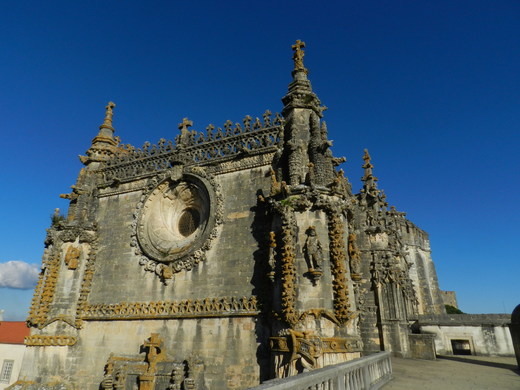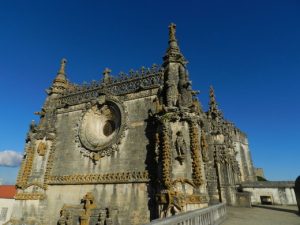Atlas Obscura recently posted a nifty little piece on one of the holdings of the Knights Templar and also their surprising fate in Portugal which included becoming the Order of Christ and holding on to this lovely castle I wonder if Ordo Templi Orientis members get reduced rate entry there?
“A magnificent castle overlooks the river Nabão. It is known as a convent, but it was built in 1160 as a headquarters for the Knights Templar, the formidable Catholic military that answered to the Pope. Even when the Moors took much of Spain and Portugal in the late 1200s, the Knights Templar held onto the castle in Tomar.”
Read the entire piece – and see da pictures! – here: http://www.atlasobscura.com/places/convento-de-cristo
Thanks to Soror Hypatia for the tip!
Meanwhile the Order of Christ is still in business after centuries of a tangled web of circumstances:
“A military order which sprang out of the famous Order of the Temple (see Knights Templars). As Portugal was the first country in Europe where the Templars settled (in 1128), so it has been the last to preserve any remnant of that order. The Portuguese Templars had contributed to the conquest of Algarve from the Moslems; they were still defending that conquest when their order was suppressed (1312) by Pope Clement V. King Diniz, who then ruled Portugal, regretted the loss of these useful auxiliaries all the more because, in the trial to which the order had been submitted everywhere throughout Christendom, the Templars of Portugal had been declared innocent by the ecclesiastical court of the Bishop of Lisbon. To fill their place, the king instituted a new order, under the name of Christi Militia (1317). He then obtained for this order the approbation of Pope John XXII, who, by a Bull (1319), gave these knights the rule of the Knights of Calatrava (see Calatrava, Military Order of) and put them under the control of the Cistercian Abbot of Alcobaca. Further, by another Bull (1323), the same pope authorized King Diniz to turn over to the new Order of Christ the Portuguese estates of the suppressed Templars, and, as many of the latter hastened to become Knights of Christ, it may fairly be said that the foundation of Dom Diniz was both in its personnel and in its territorial position a continuation in Portugal of the Order of the Temple. Seated first at Castro Marino, it was later (1357) definitively established in the monastery of Thomar, near Santarem.
“By this time, however, Portugal had rid its soil of the Moslem, and it seemed that the Order of Christ must waste its strength in idleness, when PrinceHenry, the Navigator, son of King João I, opened a new field for its usefulness by carrying the war against Islam into Africa. The conquest of Ceuta (1415) was the first step towards the formation of a great Portuguese empire beyond the seas. It may at present be taken as demonstrated, that the motive of this great enterprise was not mercenary, but religious, its aim being the conquest of Africa for Christ and His Faith. Nothing could have been more in accord with the spirit of the order, which, under Prince Henry himself as its grand master (1417-65), took up the plan with enthusiasm. This explains the extraordinary favours granted by the popes to the order — favours intended to encourage a work of evangelization. Martin V, by a Bull the text of which is lost, granted to Prince Henry, as Grand Master of the Order of Christ, the right of presentation to all ecclesiastical benefices to be founded beyond the seas, together with complete jurisdiction and the disposal of church revenues in those regions. Naturally, the clergy of these early foreign missions were recruited by preference from those priests who were members of the order, and in 1514, a Bull of Leo X confirmed to it the right of presentation to all bishoprics beyond the seas, from which a privilege afterwards arose the custom by which incumbents of such sees wear pectoral crosses of the form peculiar to the Order of Christ. After this campaign King Manoel of Portugal, in order to overcome the repugnance of the knights to remaining in African garrisons, established thirty new commanderies in the conquered territory. Leo X, in order to further increase the number of the order’s establishments, granted an annual income of 20,000 cruzadas to be derived from Portuguese church property, and, as a result of all this material assistance, the total of seventy commanderies of the order at the beginning of Manoel’s reign had become four hundred and fifty-four at its end, in 1521.”
Read more here: http://www.newadvent.org/cathen/03698b.htm


